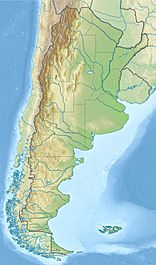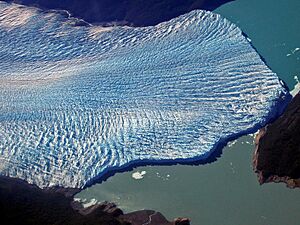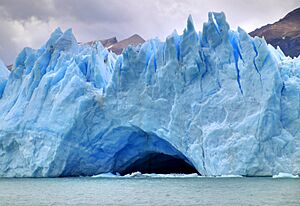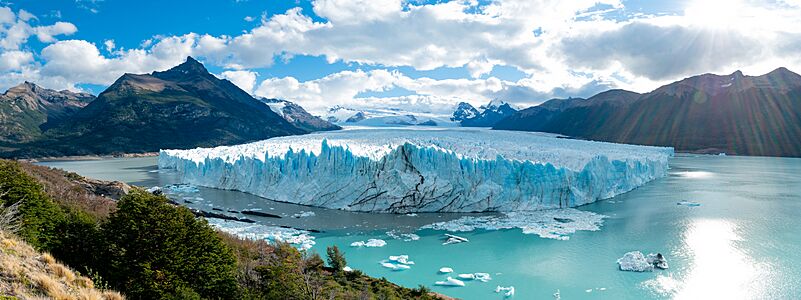Perito Moreno Glacier facts for kids
Quick facts for kids Perito Moreno Glacier |
|
|---|---|

The terminus of the glacier in Lago Argentino
|
|
| Coordinates | 50°30′S 73°08′W / 50.500°S 73.133°W |
| Area | 250 km2 (97 sq mi) |
| Length | 30 km (19 mi) |
| Width | 5 km (3 mi) |
| Thickness | 170 m (560 ft) |
| Terminus | Lago Argentino |
| Status | Retreating |
The Perito Moreno Glacier (also called Glaciar Perito Moreno in Spanish) is a massive river of ice. It is found in Los Glaciares National Park in southwest Santa Cruz Province, Argentina. This amazing glacier is also partly in Bernardo O'Higgins National Park in Chile. It is one of the most popular places to visit in the Argentine Patagonia region.
This huge ice formation covers about 250 km2 (97 sq mi) and is 30 km (19 mi) long. It is one of 48 glaciers that get their ice from the Southern Patagonian Ice Field. This ice field is located in the Andes mountains, which are shared by Argentina and Chile. The Southern Patagonian Ice Field is the third largest reserve of fresh water in the world!
The Perito Moreno Glacier is about 78 kilometres (48 mi) from a town called El Calafate. It was named after Francisco Moreno, an explorer who studied the area in the 1800s. He was very important in helping to decide the border between Argentina and Chile.
Contents
What is the Perito Moreno Glacier's Status?
Since 2020, the northern part of the glacier has been getting smaller. Scientists think this might be because of climate change. Before 2020, the Perito Moreno Glacier was unusual. It was one of the few glaciers that stayed about the same size for many years. It gained ice at almost the same rate it lost it. Scientists are still trying to figure out why it was so stable for so long.
The end of the Perito Moreno Glacier is 5 km (3.1 mi) wide. It stands about 74 m (240 ft) tall above the water of Argentino Lake in Argentina. The ice itself is about 170 metres (558 ft) deep in total.
History of the Glacier's Name
In 1879, a British captain named Juan Tomás Rogers was the first non-native person to see this grand glacier. He named it "Francisco Gormaz." This was to honor the head of the Chilean Navy's Hydrographic Office, which helped fund his trip.
Later, Rudolph Hauthal, who worked for Argentina, saw the glacier. He decided to name it "Bismarck" after the German Chancellor, Otto von Bismarck.
In 1881, Argentina and Chile signed a treaty to set their borders in the Andes mountains. The glacier is east of the Andes and flows into Lake Argentino, which is in Argentina. Before this treaty, Argentina and Chile had argued over this area.
Finally, in 1899, after much study, Lieutenant Iglesias officially named the glacier Perito Moreno. This was to honor Francisco Moreno, the explorer. Even though a small part of the glacier's origin is in Chile, most of it is in Argentina.
The Glacier's Amazing Ruptures
The Perito Moreno Glacier is famous for its incredible "ruptures." This happens when the glacier slowly pushes forward across an arm of Lake Argentino. It reaches the Península de Magallanes, which is like a small peninsula. When it touches, it creates a natural ice dam. This dam splits the lake into two parts: the Brazo Rico (Rico Arm) and the Canal de los Témpanos (Iceberg Channel).
Because the Brazo Rico is blocked, the water level in it can rise a lot. It can get up to 30 metres (98 ft) higher than the main part of Lake Argentino! Eventually, the huge pressure from all this water breaks through the ice dam. This causes a spectacular event where a massive amount of water rushes from the Brazo Rico into the main lake. You can see the old shoreline, showing how high the water got. This cycle of the glacier forming a dam and then breaking happens naturally. It can be as often as once a year or less than once every ten years.
The glacier usually moves forward between June and December. It then shrinks a bit between December and April. The way the ice dam forms is quite complex. The glacier and the lake affect each other, which helps keep the glacier's front fairly stable.
Scientists have seen different ways the water breaks through. They call them:
- Sudden ruptures: The water breaks through very quickly.
- Progressive ruptures: The process is slower, and the water escapes over a longer time.
- Minor ruptures: The glacier doesn't completely block the water, but it slows it down.
The ruptures don't happen on a set schedule. Sometimes they happen often, and other times there are many years between them.
Some of the years when ruptures happened include: 1917, 1935, 1940, 1942, 1947, 1952, 1953, 1956, 1960, 1963, 1966, 1970, 1972, 1975, 1977, 1980, 1984, 1988, 2004, 2006, 2008, 2012, 2013 (twice!), 2016, 2018, and 2019.
First Recorded Rupture (1917)
Studies of old tree rings show that there were no big damming and breaking events from about 1635 until the 1900s. The front of the glacier started moving towards the peninsula in the late 1800s. By 1899, it was only 750 meters away. In the early 1900s, it kept moving forward. It finally closed off the Brazo Rico for the first time in 1917, leading to the first recorded break.
Big Ruptures in the 21st Century
In the 2000s, some of the biggest and most watched ruptures happened in 2004, 2006, 2008, and 2012.
- In 2004, the blocked lake water rose 10.5 metres (34 ft). The water rushed out at a speed of 5,000 cubic metres per second (180,000 cu ft/s). About 10,000 tourists came to watch this amazing event!
- In 2006, the water level difference was 5.4 metres (18 ft). The ice dam broke on March 13th, and water flowed out at 5,850 cubic metres per second (207,000 cu ft/s).
- The 2008 event saw the fastest flow of water, reaching 8,000 cubic metres per second (280,000 cu ft/s)!
- In 2012, the water flow was slower, about 2,000 cubic metres per second (71,000 cu ft/s). Because of this, it took 14 days for all the blocked water to escape.
Slower Ruptures
Sometimes, the water breaks through more slowly. This happened in the summer of 2013. The glacier got very close to the peninsula, causing the Brazo Rico to fill up. The water rose 2.2 metres (7 ft 3 in) before it found a way to escape through a tunnel under the ice. This process took 85 days to finish! Another slow rupture happened in December 2013.
Small Ruptures
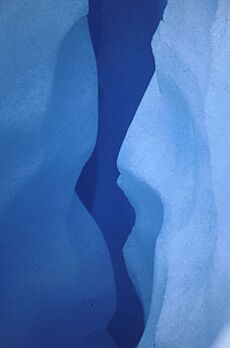
Occasionally, the glacier doesn't completely block the water. It gets close enough to slow the water down, but the water level doesn't rise much. These are called minor ruptures. This happened in 1996, 1994, 1995, and 1997. The water level in the Brazo Rico only rose about a meter.
Tourism at Perito Moreno
The Perito Moreno Glacier is a huge draw for tourists in southern Patagonia. Its amazing ruptures are considered one of the most impressive natural shows in the world! These events bring many visitors from all over, which helps the local economy. The nearby city of El Calafate is the main base for tourists. It has an international airport, and many companies offer daily tours to the glacier.
There's a large visitor center at the glacier with walkways. These walkways allow people to get great views of the glacier's southern side and its eastern edge.
In recent years, walking on the ice itself has become very popular. There are two main tours:
- Mini-trekking: A shorter walk, about an hour and a half.
- Big ice: A longer adventure, usually about five hours.
Tour companies provide special spikes for your shoes, called crampons, to help you walk safely on the ice. Sometimes, the ice bridge breaks at night when no one is watching, like in March 2018.
Amazing Animals: The Glacier Stonefly
A tiny insect called the Andiperla willinki lives on the Perito Moreno Glacier. It's also known as "the pearl of the Andes" or "dragon of Patagonia." This small insect is a type of plecoptera (stonefly) that spends its whole life on the ice of Patagonian glaciers in Argentina and Chile. It's only about 1.5 cm (0.59 in) long and eats tiny bacteria that are carried onto the ice by the wind.
This unique creature was first found on the Upsala Glacier in 1956. Because it's so rare, small, and lives in such an extreme place, people thought it might have disappeared. But it was found again in 2001 in a glacier in Torres del Paine! The people who found it called it the "Patagonian dragon."
|
See also
 In Spanish: Glaciar Perito Moreno para niños
In Spanish: Glaciar Perito Moreno para niños


